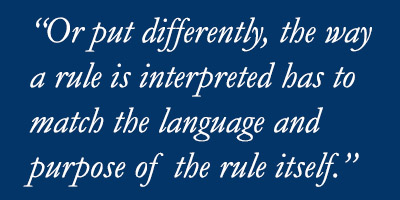Legal rules set f orth certain requirements, but every rule is subject to interpretation and application to the specific facts of the case. Say you are seeking a ruling from a Court to depart slightly from the literal requirements of a rule. The rule says one thing, but you are urging some flexibility in the way the rule is to be interpreted and applied.
orth certain requirements, but every rule is subject to interpretation and application to the specific facts of the case. Say you are seeking a ruling from a Court to depart slightly from the literal requirements of a rule. The rule says one thing, but you are urging some flexibility in the way the rule is to be interpreted and applied.
What’s the best method to advance such an argument? Simply suggesting a more “reasonable” interpretation will often not work since the Court is provided with no rationale to justify departing from the terms of the rule. After all, the rule was put into place for a purpose.
Typical approaches include arguing that the rule does not apply to the particular set of facts at issue; arguing that the language of the rule can be read to encompass the result sought; or arguing that the rule has to be read in the context of other rules and, if these other rules are considered, the interpretation sought makes the most sense.
But there are other methods as well. For example, one can set out for the Court the extremes—arguing that rule would lead to impractical or irrational results if it were interpreted and applied in a manner other than what’s being suggested. That is, one can hypothesize the rule’s language to be utterly inflexible, and point out the impracticalities and difficulties of such an approach. Then, in the alternative, one can hypothesize the rule’s language to be somewhat more flexible, and point out why the purposes sought to be achieved by the rule are best advanced by this more adaptable approach.
In other words, flexibility has to be made an inherent part of the rule itself—not imposed upon it from the outside. Or put differently, the way a rule is interpreted has to match the language and purpose of the rule itself. If the Court can be made to see that flexibility in interpretation is an inherent part of the rule, the Court may be more likely to apply the rule in a flexible manner.
The language of the rule and how other courts have interpreted this language will be important markers. But the underlying rationale for the rule and its intended outcomes when followed are equally as important. What’s the best method? There’s no best method, but the first method should focus on the language of the rule itself—and then urge an interpretation which follows naturally, inexorably.




